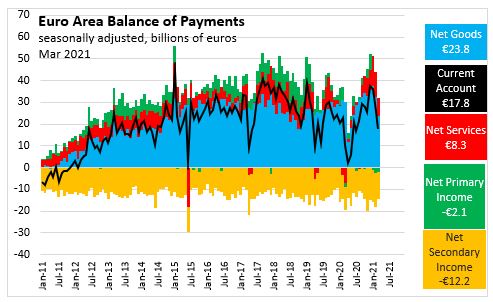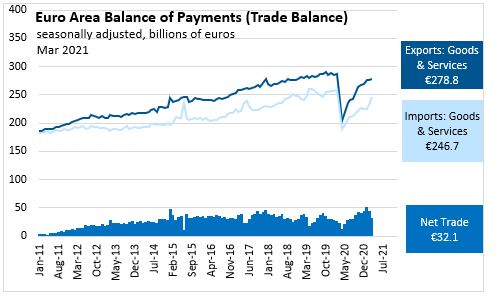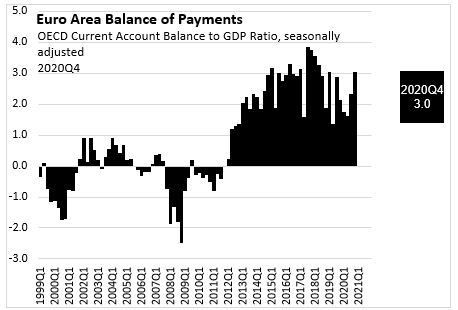The Economics and Statistics Division maintains archives of previous publications for accountability purposes, but makes no updates to keep these documents current with the latest data revisions from Statistics Canada. As a result, information in older documents may not be accurate. Please exercise caution when referring to older documents. For the latest information and historical data, please contact the individual listed to the right.
<--- Return to Archive
For additional information relating to this article, please contact:
May 20, 2021EURO AREA CURRENT ACCOUNT, MARCH 2021 
Month over month (Mar 2021 vs Feb 2021, seasonally adjusted)
The European Central Bank reported today that the Euro Area (EA19) Current account surplus narrowed by €8.0 billion to €17.8 billion
Net trade surplus narrowed by €11.9 billion to €32.1 billion
- Exports of goods and services increased €2.6 billion to €278.8 billion
- Imports of goods and services increased €14.5 billion to €246.7 billion As a result,
Net Goods surplus narrowed by €8.7 billion to €23.8 billion
- Goods exports increased €3.6 billion to €201.5 billion while
- Goods Imports increased €12.3 billion to €177.7 billion
Net Services surplus narrowed by €3.2 billion to €8.3 billion.
Net Primary Income deficit narrowed by €0.2 billion to €2.1 billion.
Net Secondary Income deficit narrowed by €3.7 billion to €12.2 billion.

CURRENT ACCOUNT AS A SHARE OF GDP (2020Q4 vs 2020Q3)
Euro area's current account (as measured as a share of GDP) widened 0.7 percentage points to 3.0%.

2021Q1 data will be available later this month
The ratio of the current account balance to the Gross Domestic Product (or % of GDP) provides an indication of the country's trade and income flows relative to the size of the economy.
The ratio is calculated by dividing the net values of exports less imports, primary Income (interest and dividends) and secondary income (transfers) over a period by the gross domestic product for the same period. Although called a ratio, it is usually expressed as a percentage.
A current account surplus indicates upward pressure on the foreign exchange rate unless it is offset by net outflows (leading, acquisition of assets) outside the country the gross domestic product for the same period. Although called a ratio, it is usually expressed as a percentage. A current account surplus indicates upward pressure on the foreign exchange rate unless it is offset by net outflows (leading, acquisition of assets) outside the country.
REFERENCE
European Central Bank. Press Release | Database | Selected Current Account Data
OECD. EA19 CURRENT ACCOUNT AS A % OF GDP seasonally adjusted
<--- Return to Archive